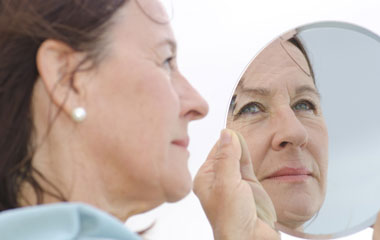Skin care is very important at any age but as you get older, you need to take extra care of your skin. With aging, the skin undergoes a number of natural changes, including loss of elasticity and ability to return to its normal shape. However, skin aging also depends on factors such as lifestyle, diet, heredity, and personal habits (such as smoking). The good news is that taking certain steps can keep your skin healthy at any age.

- Roughened or dry skin
- Benign growths
- Loose facial skin, especially around the eyes, cheeks, and jawline
- Transparent or thinned skin
- Bruising easily due to reduced elasticity
Common Skin Conditions among Older Adults
The skin conditions specific to older adults are as follows:
- Wrinkles: This is one most common visible signs of aging. Wrinkles develop over time due to the effects of gravity. Smoking can cause the skin to wrinkle prematurely and UV rays can deplete skin elasticity.
While wrinkles can’t be cured, the appearance of wrinkles caused by sun damage can be reduced through the use of tretinoin (Renova). Talk with your doctor if you are worried about wrinkles.
- Acne: This is another common skin problem among younger people and the elderly. An article in Everyday Health cites a 2016 report from the American Academy of Dermatology which reported that acne is the most common skin condition in the United States, affecting up to 50 million people every year. Commonly appearing on the face, neck, shoulders, chest, and upper back, acne may leave scars or darken the skin if untreated.
Simple homemade face masks may work for acne. If they do not, see a dermatologist for proper treatment.
- Facial movement lines: Known as “laugh lines” and “worry lines,” these become more visible as the skin loses its elasticity (in your 40s or 50s). They typically appear on the forehead, nose, the temples, upper cheeks, and around the mouth and eyes. Facial lines form due to daily facial movements such as smiling and frowning.
- Dry and itching skin: Many elderly people suffer from dry spots on the skin, often on the lower legs, elbows, and lower arms. This mainly occurs due to the loss of oil glands which help to keep the skin soft. According to National Institute on Aging, the possible reasons for dry skin include
- Not drinking enough liquids
- Spending too much time in the sun
- Being in very dry air
- Smoking
- Feeling stress
- Losing sweat and oil glands, which is common with age
In some cases, dry, itchy skin may be a sign indicator of health disease such as a sign of diabetes, kidney disease, or liver disease.
The best treatment for dry skin is to moisturize your skin daily. Use moisturizers such as creams, lotions or ointments everyday as it helps to trap the moisture on the skin. Take fewer baths or showers as frequent bathing can aggravate dry skin; importantly, use warm rather than hot water. Humidifiers also help to hydrate the skin. If these tips don’t work and your skin is very dry and itchy, see your doctor.
- Age spots: Aging can cause brown patches on sun-exposed parts of the body (face, hands, and forearms). These spots are flat and are bigger than freckles, but harmless. Using a broad-spectrum sunscreen can help protect against two types of the sun’s rays, UVA and UVB, and prevent these age spots from appearing.
- Skin cancer: Skin cancer, which s a very common type of cancer in the United States, occurs due to sun exposure.
If you notice a mole changing appearance or new skin growth, get an evaluation by a dermatologist. A biopsy will be recommended if skin cancer is suspected. - Bed Sores: Also known as pressure ulcers, this skin problem is seen in people with impaired mobility. Frequent rotation or re-positioning can help prevent bedsores.
Recognizing common skin concerns among older adults, from wrinkles to dryness, and understanding effective management strategies is crucial for maintaining skin health and overall well-being. By adopting preventive measures, seeking professional guidance when needed, and staying attentive to skin changes, individuals can navigate the aging process with grace and minimize the impact of age-related skin conditions.
